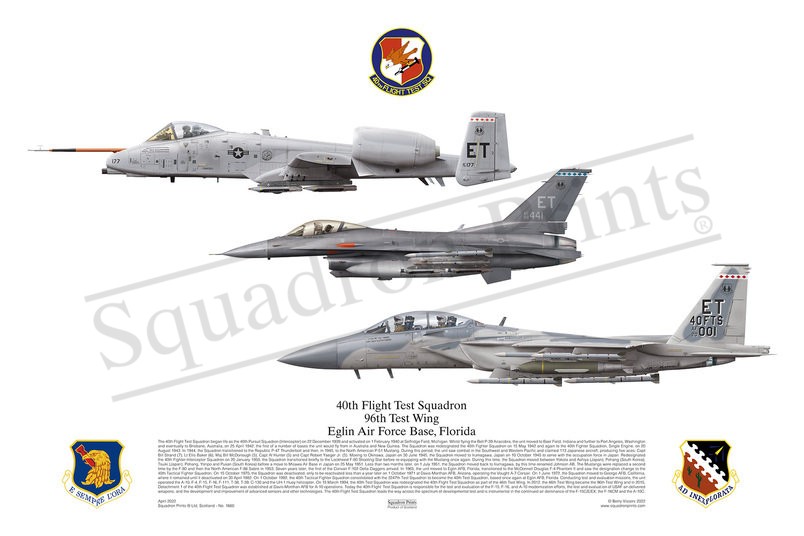#1660 40th FLTS A-10C, F-16C and F-15EX print

Description
Squadron Prints Lithograph No. 1660 - 40th Flight Test Squadron, 96th Test Wing, Eglin AFB, Florida.
The 40th Flight Test Squadron began life as the 40th Pursuit Squadron (Interceptor) on 22 December 1939 and activated on 1 February 1940 at Selfridge Field, Michigan. Whilst flying the Bell P-39 Airacobra, the unit moved to Baer Field, Indiana and further to Port Angeles, Washington and eventually to Brisbane, Australia, on 25 April 1942, the first of a number of bases the unit would fly from in Australia and New Guinea. The Squadron was redesignated the 40th Fighter Squadron on 15 May 1942 and again to the 40th Fighter Squadron, Single Engine, on 20 August 1943. In 1944, the Squadron transitioned to the Republic P-47 Thunderbolt and then, in 1945, to the North American P-51 Mustang. During this period, the unit saw combat in the Southwest and Western Pacific and claimed 113 Japanese aircraft, producing five aces; Capt Bill Strand (7), Lt Ellis Baker (6), Maj Bill McDonough (5), Capt Al Hunter (5) and Capt Robert Yaeger Jr. (5). Moving to Okinawa, Japan on 30 June 1945, the Squadron moved to Irumagawa, Japan on 10 October 1945 to serve with the occupation force in Japan. Redesignated the 40th Fighter-Interceptor Squadron on 20 January 1950, the Squadron transitioned briefly to the Lockheed F-80 Shooting Star before re-equipping with the Mustang once again. During this time, the Squadron moved between Yokota and Ashiya (Japan), Pohang (South Korea), Tsuiki (Japan), Pohang, Yonpo and Pusan (South Korea) before a move to Misawa Air Base in Japan on 25 May 1951. Less than two months later, on 1 July 1951, the Squadron moved back to Irumagawa, by this time renamed Johnson AB. The Mustangs were replaced a second time by the F-80 and then the North American F-86 Sabre in 1953. Seven years later, the first of the Convair F-102 Delta Daggers arrived. In 1965, the unit moved to Eglin AFB, Florida, transitioned to the McDonnell Douglas F-4 Phantom II and saw the designation change to the 40th Tactical Fighter Squadron. On 15 October 1970, the Squadron was deactivated, only to be reactivated less than a year later on 1 October 1971 at Davis-Monthan AFB, Arizona, operating the Vought A-7 Corsair. On 1 June 1972, the Squadron moved to George AFB, California, where it remained until it deactivated on 30 April 1982. On 1 October 1992, the 40th Tactical Fighter Squadron consolidated with the 3247th Test Squadron to become the 40th Test Squadron, based once again at Eglin AFB, Florida. Conducting test and evaluation missions, the unit operated the A-10, F-4, F-15, F-16, F-111, T-38, T-39, C-130 and the UH-1 Huey helicopter. On 15 March 1994, the 40th Test Squadron was redesignated the 40th Flight Test Squadron as part of the 46th Test Wing. In 2012, the 46th Test Wing became the 96th Test Wing and in 2015, Detachment 1 of the 40th Flight Test Squadron was established at Davis-Monthan AFB for A-10 operations. Today the 40th Flight Test Squadron is responsible for the test and evaluation of the F-15, F-16, and A-10 modernization efforts, the test and evaluation of USAF air-delivered weapons, and the development and improvement of advanced sensors and other technologies. The 40th Flight Test Squadron leads the way across the spectrum of developmental test and is instrumental in the continued air dominance of the F-15C/E/EX, the F-16CM and the A-10C.
You may also like
-
various
variousLondon Air Traffic Control CentreRAF Brize Norton; RAF Cranwell; RAF Lakenheath; RAF Linton-on-Ouse; RAF Lyneham; RAF Marham; RAF Mildenhall; RAF Valley; RAF Wittering; RAF Coningsby
